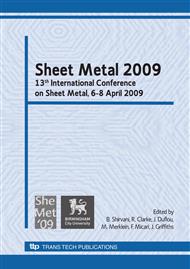p.177
p.187
p.197
p.207
p.217
p.227
p.235
p.245
p.255
Investigation of the Mechanical Behavior of a PU-Based Coil-Coating System with the Help of Indentation and FE Analysis
Abstract:
One-component polyurethane coatings on galvanized sheet steel are widely used to suppress white rust of the car body. To fulfill the requirements of corrosion resistance and aesthetics, such coatings have to withstand sheet forming and assembling operations without being damaged. Damage - which in the wide sense encompasses pores, surface and interface microcracks - would mean an inacceptable reduction in corrosion resistance and aesthetics deterioration. Therefore, understanding of coating damage initiation due to sheet forming becomes a key issue for producers of coating materials and forming technologists. To study coating performance in a forming process, FE simulations can be employed. This requires, however, an appropriate constitutive model of the coating and accurately determined model parameters. The present work investigates a two-layer coil-coating system Coilprime C manufactured by the BASF Coatings AG. The system consists of a primer with a thickness of approximately 5 µm and an intercoat, which is about 20 µm thick, both being based on a polyurethane (PU) resin. Applicability of indentation for determination of mechanical properties of the intercoat is studied. The experiments were carried out with a Hysitron TriboindenterTM using a conospherical indenter. In the experiments, the intercoat exhibited viscoelastoplastic behaviour. In the FE simulations of the indentation test, the intercoat and the primer were assumed to be a single continuum with a constitutive behaviour described as a combination of hyperelasticity defined by the Arruda-Boyce strain energy potential and ideal plasticity defined by the rate-independent von Mises yield surface. The full deformation is modelled using a multiplicative split of the deformation gradient into hyperelastic and plastic components.
Info:
Periodical:
Pages:
217-224
Citation:
Online since:
March 2009
Price:
Сopyright:
© 2009 Trans Tech Publications Ltd. All Rights Reserved
Share:
Citation:


